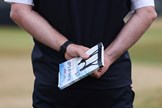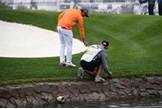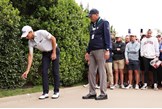Rules of Golf: 2023 update explained
Published: Last updated:
The R&A and the USGA have unveiled an update to the Rules of Golf for 2023 in a bid to make them easier to understand and apply. We delve into the key changes to explain how they will impact your game.
It’s already been four years since the R&A and USGA made the biggest changes to the Rules of Golf that we had seen in a generation, meaning it’s time for the first review of the laws.
Coming into force on January 1, 2023, the update isn’t as substantial as the one we saw in 2019 (relief areas and knee-high drops!), but there are 40 substantive changes with four Model Local Rules altered or added.
The new edition places an emphasis on both inclusion and sustainability and, for the first time, the modified Rules for players with disabilities have been fully incorporated into the playing rules without the need to adopt a local rule.

Several penalties have been relaxed and language has been clarified to help golfers at all levels of play, while the governing bodies will significantly reduce the production and distribution of more than four million printed books, choosing instead to promote digital and mobile app access to the Rules.
RELATED: World Handicap System explained
“We are continuing to improve and adapt the Rules of Golf to ensure they are in line with the way the modern game is played,” Grant Moir, Director of Rules at The R&A, said. “That means making the Rules easier to understand and access for all golfers and making the sport more inclusive and welcoming for golfers with disabilities. We are also working to ensure golf has a sustainable long-term future and making more resources available digitally is key to achieving that goal.”
“The growing popularity of golf continues to guide our decision-making and modernising the Rules to promote inclusivity and accessibility is clearly a great step in the right direction,” Thomas Pagel, USGA Chief Governance Officer said. “This latest evolution is especially important to the community of golfers with disabilities, and we hope it will encourage more people to play and enjoy the game.”
Key changes to the Rules of Golf for 2023

No penalties for failing to put handicaps on the scorecard
As it stands, failing to put your handicap on your scorecard would mean disqualification, regardless of how you performed, but an amendment to Rule 3.3b (4) for 2023 means this will no longer be a requirement.
The R&A and USGA have decided that with the continued growth of score-posting technology following the adoption of the World Handicap System that the competition committee will be responsible for ensuring the accuracy of each player’s handicap and calculating it.
Clubs could use a new Model Local Rule, though, to put the responsibility back on the player.
RELATED: The biggest rules change for a generation
You can replace a club if it gets damaged during your round
Don’t immediately think you can start snapping clubs over your knee or wrapping them around a tree after every bad shot. This change to Rule 4.1a (2) allows players to replace a club that is damaged during a round as long as that damage has not been caused by abuse.
If the clubhead flies off when you hit a drive, your iron bends because you didn’t spot a tree root, or you take a lump out of the face of a wedge when you catch a stone then you can replace that club. Unfortunately, unlike the Tour pros, it will be of limited benefit to those of us who don’t have Tour trucks on site!

You can replace a ball moved by natural forces
This exception to Rule 9.3 was inspired by an incident that occurred just weeks after the 2019 rule changes.
Rickie Fowler was leading that year’s Waste Management Phoenix Open by five shots when he chipped into a water hazard on the 11th hole. After twice seeing his attempted drops in the penalty area, situated on a steep bank, roll back into the water, Fowler placed his ball and went to survey his shot, only for the ball to again roll back into the water, costing him another penalty and leading to a triple-bogey.
The incident caused debate to rage on social media and made the authorities reexamine the rule. For 2023, any ball that is caused to move to another area of the course after being dropped, placed or replaced, must be replaced without penalty. This is also the case if the ball comes to rest out of bounds.

Back-on-the-line relief made simpler
The procedure for taking penalty area or unplayable ball relief will be simpler from 2023, meaning that when players drop the ball on their line it must come to rest within one club length of where it was dropped. And, before you ask, the club length can be in any direction, including forwards.
RELATED: 16 fun golf formats you have to try
You can’t replay your stroke if your ball hits an insect on the green
An exception to Rule 11.1b said that when a ball played from the putting green accidentally hit any person, animal, or movable obstruction on the green, that stroke didn’t count. Model Local Rule D-7, though, limited a lot of those instances.
The rule has now been amended so if a ball played from the putting green hits the player, the club the player used to make the stroke, an insect or a similar animal defined as a loose impediment, the stroke counts and the ball is played as it lies.
Stableford penalties simplified
You’d have thought that carrying too many clubs or arriving late for a Stableford event would have been penalised by you scoring zero points on the offending hole but, until this update, it has been far more complicated.
Thankfully Rule 21.1c has been amended so those penalties are now applied to the hole in the same way as regular stroke play. So, for example, having 15 clubs in your bag in stroke play would mean adding two penalty strokes for each hole where a breach happened, up a maximum of four penalty strokes in the round.
This amendment also applies to the same penalties in Par/Bogey competitions as well. After applying any penalty strokes, a player’s Stableford score for a hole “cannot be lower than zero points”.
You can’t stand behind your partner to gain information about your side’s next stroke
If, once you begin taking a stance for a stroke, your partner is stood in a location “on or close to an extension of the line of play behind the ball”, you are in breach of Rule 10.2b (4).
Now, in addition, Rule 22.6 in foursomes and Rule 23.8 in fourballs bans a player from doing this while their partner is making a stroke to “gain information for their next stroke”.
For more information on the Rules of Golf visit randa.org or usga.org/rules. Full updates to the official Rules of Golf digital applications will be available from January 1.
The current edition of the Rules of Golf (2019) still applies when playing or posting scores for the remainder of 2022.
RELATED: How non-members can get an official handicap
Join Today’s Golfer for unlimited access to premium content and exclusive rewards!
-
 The R&A and USGA are looking to change the rules on golf balls
The R&A and USGA are looking to change the rules on golf balls
-
 Clubs that are damaged by accident will be able to be replaced under the Rules of Golf 2023.
Clubs that are damaged by accident will be able to be replaced under the Rules of Golf 2023.
-

-

-
 Unlike 2019, Rickie Fowler would no longer be punished if his placed golf ball rolled back into the water.
Unlike 2019, Rickie Fowler would no longer be punished if his placed golf ball rolled back into the water.
-
 Will Zalatoris takes a drop for an unplayable lie.
Will Zalatoris takes a drop for an unplayable lie.
